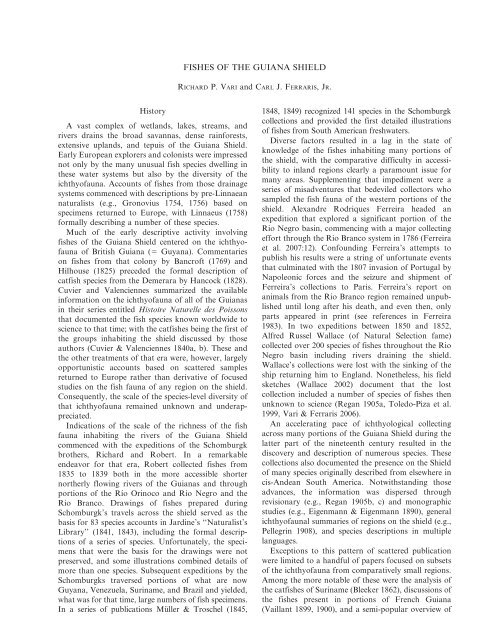Biological Society of Washington - Department of Botany ...
Biological Society of Washington - Department of Botany ...
Biological Society of Washington - Department of Botany ...
You also want an ePaper? Increase the reach of your titles
YUMPU automatically turns print PDFs into web optimized ePapers that Google loves.
History<br />
A vast complex <strong>of</strong> wetlands, lakes, streams, and<br />
rivers drains the broad savannas, dense rainforests,<br />
extensive uplands, and tepuis <strong>of</strong> the Guiana Shield.<br />
Early European explorers and colonists were impressed<br />
not only by the many unusual fish species dwelling in<br />
these water systems but also by the diversity <strong>of</strong> the<br />
ichthy<strong>of</strong>auna. Accounts <strong>of</strong> fishes from those drainage<br />
systems commenced with descriptions by pre-Linnaean<br />
naturalists (e.g., Gronovius 1754, 1756) based on<br />
specimens returned to Europe, with Linnaeus (1758)<br />
formally describing a number <strong>of</strong> these species.<br />
Much <strong>of</strong> the early descriptive activity involving<br />
fishes <strong>of</strong> the Guiana Shield centered on the ichthy<strong>of</strong>auna<br />
<strong>of</strong> British Guiana (5 Guyana). Commentaries<br />
on fishes from that colony by Bancr<strong>of</strong>t (1769) and<br />
Hilhouse (1825) preceded the formal description <strong>of</strong><br />
catfish species from the Demerara by Hancock (1828).<br />
Cuvier and Valenciennes summarized the available<br />
information on the ichthy<strong>of</strong>auna <strong>of</strong> all <strong>of</strong> the Guianas<br />
in their series entitled Histoire Naturelle des Poissons<br />
that documented the fish species known worldwide to<br />
science to that time; with the catfishes being the first <strong>of</strong><br />
the groups inhabiting the shield discussed by those<br />
authors (Cuvier & Valenciennes 1840a, b). These and<br />
the other treatments <strong>of</strong> that era were, however, largely<br />
opportunistic accounts based on scattered samples<br />
returned to Europe rather than derivative <strong>of</strong> focused<br />
studies on the fish fauna <strong>of</strong> any region on the shield.<br />
Consequently, the scale <strong>of</strong> the species-level diversity <strong>of</strong><br />
that ichthy<strong>of</strong>auna remained unknown and underappreciated.<br />
Indications <strong>of</strong> the scale <strong>of</strong> the richness <strong>of</strong> the fish<br />
fauna inhabiting the rivers <strong>of</strong> the Guiana Shield<br />
commenced with the expeditions <strong>of</strong> the Schomburgk<br />
brothers, Richard and Robert. In a remarkable<br />
endeavor for that era, Robert collected fishes from<br />
1835 to 1839 both in the more accessible shorter<br />
northerly flowing rivers <strong>of</strong> the Guianas and through<br />
portions <strong>of</strong> the Río Orinoco and Río Negro and the<br />
Rio Branco. Drawings <strong>of</strong> fishes prepared during<br />
Schomburgk’s travels across the shield served as the<br />
basis for 83 species accounts in Jardine’s ‘‘Naturalist’s<br />
Library’’ (1841, 1843), including the formal descriptions<br />
<strong>of</strong> a series <strong>of</strong> species. Unfortunately, the specimens<br />
that were the basis for the drawings were not<br />
preserved, and some illustrations combined details <strong>of</strong><br />
more than one species. Subsequent expeditions by the<br />
Schomburgks traversed portions <strong>of</strong> what are now<br />
Guyana, Venezuela, Suriname, and Brazil and yielded,<br />
what was for that time, large numbers <strong>of</strong> fish specimens.<br />
In a series <strong>of</strong> publications Müller & Troschel (1845,<br />
FISHES OF THE GUIANA SHIELD<br />
RICHARD P. VARI and CARL J. FERRARIS, JR.<br />
1848, 1849) recognized 141 species in the Schomburgk<br />
collections and provided the first detailed illustrations<br />
<strong>of</strong> fishes from South American freshwaters.<br />
Diverse factors resulted in a lag in the state <strong>of</strong><br />
knowledge <strong>of</strong> the fishes inhabiting many portions <strong>of</strong><br />
the shield, with the comparative difficulty in accessibility<br />
to inland regions clearly a paramount issue for<br />
many areas. Supplementing that impediment were a<br />
series <strong>of</strong> misadventures that bedeviled collectors who<br />
sampled the fish fauna <strong>of</strong> the western portions <strong>of</strong> the<br />
shield. Alexandre Rodriques Ferreira headed an<br />
expedition that explored a significant portion <strong>of</strong> the<br />
Rio Negro basin, commencing with a major collecting<br />
effort through the Rio Branco system in 1786 (Ferreira<br />
et al. 2007:12). Confounding Ferreira’s attempts to<br />
publish his results were a string <strong>of</strong> unfortunate events<br />
that culminated with the 1807 invasion <strong>of</strong> Portugal by<br />
Napoleonic forces and the seizure and shipment <strong>of</strong><br />
Ferreira’s collections to Paris. Ferreira’s report on<br />
animals from the Rio Branco region remained unpublished<br />
until long after his death, and even then, only<br />
parts appeared in print (see references in Ferreira<br />
1983). In two expeditions between 1850 and 1852,<br />
Alfred Russel Wallace (<strong>of</strong> Natural Selection fame)<br />
collected over 200 species <strong>of</strong> fishes throughout the Rio<br />
Negro basin including rivers draining the shield.<br />
Wallace’s collections were lost with the sinking <strong>of</strong> the<br />
ship returning him to England. Nonetheless, his field<br />
sketches (Wallace 2002) document that the lost<br />
collection included a number <strong>of</strong> species <strong>of</strong> fishes then<br />
unknown to science (Regan 1905a, Toledo-Piza et al.<br />
1999, Vari & Ferraris 2006).<br />
An accelerating pace <strong>of</strong> ichthyological collecting<br />
across many portions <strong>of</strong> the Guiana Shield during the<br />
latter part <strong>of</strong> the nineteenth century resulted in the<br />
discovery and description <strong>of</strong> numerous species. These<br />
collections also documented the presence on the Shield<br />
<strong>of</strong> many species originally described from elsewhere in<br />
cis-Andean South America. Notwithstanding those<br />
advances, the information was dispersed through<br />
revisionary (e.g., Regan 1905b, c) and monographic<br />
studies (e.g., Eigenmann & Eigenmann 1890), general<br />
ichthy<strong>of</strong>aunal summaries <strong>of</strong> regions on the shield (e.g.,<br />
Pellegrin 1908), and species descriptions in multiple<br />
languages.<br />
Exceptions to this pattern <strong>of</strong> scattered publication<br />
were limited to a handful <strong>of</strong> papers focused on subsets<br />
<strong>of</strong> the ichthy<strong>of</strong>auna from comparatively small regions.<br />
Among the more notable <strong>of</strong> these were the analysis <strong>of</strong><br />
the catfishes <strong>of</strong> Suriname (Bleeker 1862), discussions <strong>of</strong><br />
the fishes present in portions <strong>of</strong> French Guiana<br />
(Vaillant 1899, 1900), and a semi-popular overview <strong>of</strong>
















